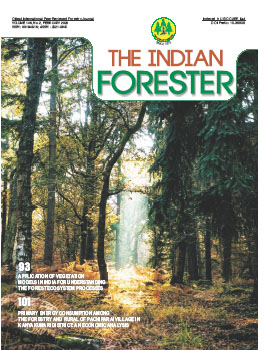Plant Taxonomic Diversity: An Assessment on Gandhamardan Hill Range of Western Odisha, India
DOI:
https://doi.org/10.36808/if/2020/v146i2/145204Keywords:
Taxonomic Diversity, Gandhamardan, Western Odisha.Abstract
Present study records 232 plant species which is 8.5% of total 2727 species found in Odisha. All species are distributed over six prevalent forest types such as Tropical semi-evergreen forest, Tropical drydeciduous forest, Scrub-woodland, Bamboo forest, Scrub forest and Grass land of Gandhamardan hill ranges. Tree, shrub, LTC (Lianas, Twinner and Climber) and herb represent 37.50%, 15.09%, 12.07% and 35.34% of the total species. 232 plant species comes under 189 genera and 66 families. Tree community having GBH > 15cm (Tree-1) consists of 86 species, 71 genera and 35 families. Tree community having GBH < 15cm (Tree-2) has 58 species, 51 genera and 30 families. Shrub community represents 34 species, 33 genera and 23 families. LTC represents 26 species, 21 genera and 12 families. Herb community represents 82 species, 69 genera and 25 families. Similarly, seedling community is having 101 species, 90 genera and 44 families. The ten most dominant families in the region are Poaceae, Fabaceae, Rubiaceae, Euphorbiaceae, Acanthaceae, Lamiaceae, Cyperaceae, Moraceae, Rhamnaceae and Apocynaceae. 161 out of total 189 genera are represented by single species. In other words, 69% of total species occurrence is spread over 85% of total genera which indicates the higher taxonomic diversity of the forest area.References
Bhadra A.K. and Dhal N.K. (2010). Tree seedling diversity in the protected natural forest of Gandhamardan hill ranges. The Bioscan, 2: 451-459.
Bhadra A.K. and Pattanayak S.K. (2016). Abundanceor Dominance: Which is morejustified to calculate Importance Value Index (IVI) of plant species? Asian Journal ofScience and Technology, 7(9): 3577-3601.
Bhadra A.K. and Pattanayak S.K. (2017). Dominance is more justified than Abundance to calculate Importance Value Index (IVI) of plant species. Asian Journal ofScience and Technology, 8(2): 4304-4326.
Bhadra A.K., Dhal N.K. and Pattanayak S.K. (2014). Altitude based tree species occurrence in the protected natural forest of Gandhamardan Hill ranges, Balangir, Odisha. Biolife, 2(2): 420-441.
Bhadra A.K., Dhal N.K. and RajareddyV. (2010). Phytosociology of the tree community of Gandhamardan hill ranges. Indian Forester, 136(5): 610 - 620.
Bhadra A.K., Dhal N.K. and Rout N.C. (2009). Assessment of floristic diversity in the Harishankar protected forest area of Gandhamardan Hill ranges using Shannon-Wienerindex. Plant Science Research, 31(1&2): 71-77.
Bhadra A. K, PattanayakS.K. and Dhal N.K. (2016). Mid-domain effect: A hypothesis testing in the Gandhamardan natural forest of Bargarh and Balangirdistricts, Odisha, India. Biolife, (4)2: 308-326.
Bhadra A.K., Sahu S.C. and Dhal N.K. (2010). Indigenous herbal treatment forchronic Suppurative otitis media (CSOM) among Kondh tribe of Bolangir District, Odisha, India-A case study. Biohelica, 1(1): 38-40.
Champion H.G. and Seth S.K. (1968). A Revisedsurveyof the foresttypes oflndia. Managerof Publications, Government of India, New Delhi.
Haines H.H. (1921-1925). The Botany of Biharand Orissa. Adlard & Son Ltd, London.
Hooker J.D. (1872-1897). The flora of British India, London.
Legris P. and Meher-Homji V.M. (1982). The Eastern Ghats: Vegetation and Bioclimatic aspects. In: Proc. Seminaron Resources, development & Environment in the Eastern Ghats, pp.1-17.
Magurran A.E. (1988). Ecological Diversity and its Measurement. Princeton University Press. New Jersey. 1-192.
Misra R.C. (1990). Ethnobotanical studies on some plants of Nrusinghanath-Harishankar complex. OrissaJourn. Env. Sci., 3(2): 36-42.
Misra R.C. (1994). Studies on the flora and remote sensing of natural resources of Nrusinghanath Harishankar Complex, Odisha, Ph.D. Thesis, BerhampurUniversity, Odisha.
Misra R.C. (1996). New plant records for Orissa state. J. Economic and Taxonomic Botany, 20(3): 635-637.
Misra R.C. and Das P. (1998a). Phytogeographical affinities of plants of Gandhamardan hill ranges of Orissa with major Indian mountains. J. Economic and Taxonomic Botany, 22(1): 207-210.
Misra R.C. and Das P. (1998b). Inventory of rare and endangered vascular plants of Gandhamardan hill ranges in western Orissa. J. Economic and Taxonomic Botany, Bot. 22(2): 353-357.
Misra R.C. and Das P. (1998c). Vegetation status of Nrusinghanath-Harishankarcomplex, Orissa. J. Economic and Taxonomic Botany, 22(3): 547-554.
Mishra R. (1968). Ecology WorkBook. Oxford and IBH Publications, Co. New Delhi.
Mishra R.C. and Das P. (2003). Wild poisonous seeds: some notable species from Gandhamardan Hill ranges of Orissa. J. Economic and Taxonomic Botany, 27(3): 513-518.
Mishra R.C., Panda PC. and Das P. (2001). A taxonomic study of the ferns and fern allies of Gandhamardan hills, Orissa. J. Economic and Taxonomic Botany, 25(3): 577-590.
Mooney H. (1950). Supplements the BotanyofBiharand Orissa. (Rep. Ed.) International Book Distributors, Dehradun, India. 1-308.
Panda S. and Das P. (2004). Flora of Sambalpur, Orissa. Bishen Singh Mahendra Pal Singh Publications, Dehradun. 1-480.
Panigrahi G., Chowdhury S., Raju D.C.S. and Deka G.K. (1964). A contribution to the botany of Orissa. Bulletin of Botanical Surveyoflndia, 6: 237-266.
Pielou E.C. (1975). Ecological diversity. Wiley Publications, New York. 1-165.
Raju D.C.S. (1960). Vegetation pattern of Gandhamardan hills. Bull. Int. Soc. Trop. Ecol., 1: 21-22.
Reddy S.C. and Pattanaik C. (2009). An assessment of floristic diversity of Gandhamardan hill range, Orissa, India. Bangladesh J. Plant Taxon., 16(1): 29-36.
Sahu S.C., Bhadra A.K. and Dhal N.K. (2010a). Rediscovery of Tephrosia tinctoria Pers. (Fabaceae) from Orissa, India. Phytotaxonomy, 9: 72-74.
Sahu S.C., Dhal N.K. and Bhadra A.K. (2010b). Arboreal Taxa Diversity of tropical forests of Gandhamardan Hill range, Eastern Ghats, India: An approach to sustainable biodiversityconservation. Taiwania, 55(3): 208-215.
Saxena H.O. and Brahmam M. (1995). Vascular flora of Gandhamardan hills. J. Economic and Taxonomic Botany, 19: 113-132.
Saxena H.O. and Brahmam M. (1996). The flora of Orissa. Vol l-IV. Orissa Forest Development Corporation Ltd, Bhubaneswar, India.
Whittaker R. H. (1960). Vegetation of the Siskiyou Mountains, Oregon and California. Ecological Monographs. 30: 279-338.
Whittaker R. H. (1972). Evolution and Measurement of Species Diversity. Taxon, 21: 213-251
Downloads
Downloads
Published
How to Cite
Issue
Section
License
Unless otherwise stated, copyright or similar rights in all materials presented on the site, including graphical images, are owned by Indian Forester.





